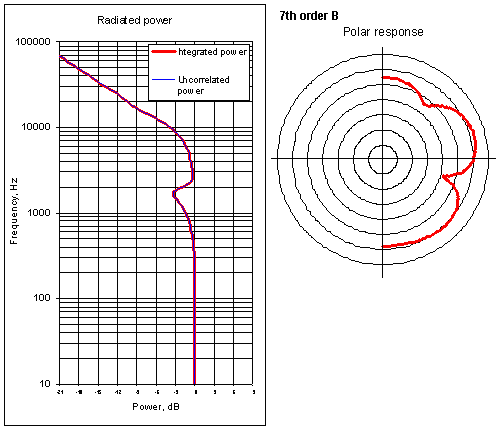Tech Design.....
___________________________
Consideration of Power Response in Speaker Design: Crossover
Choice and Setup.
Page 2
We proceed by repeating the same calculations but now introducing drivers of finite diameter and
including the effects of off axis radiation. The driver model is that of a flat piston is an infinite baffle.
This model is suitable at frequencies above the baffle step and should provide a reasonable
approximation for our example. The tweeter diameter is taken at 1" and the woofer as 6".
The results, shown below, reveal several items of interest. First, the Butterworth crossovers no longer
have flat power response which is primarily a result of the increasing directionality of the woofer as
the frequency rises. Second, the Butterworth crossovers still have smoother power response than the
Linkwitz types, regardless of order. Third, as the crossover order increases the width of the
depression in the power response becomes narrower. It is not clear whether this is a favorable result.
Since the ratio of direct to reflected sound will be greater in the region where there is reduced total
power, and since a higher ratio of direct sound generally implies greater clarity and localization, it is
possibly that narrower, more abrupt variation in the power response of a higher order crossover may
result in some apparent emphasis of frequencies in this range. This is speculative, but somewhat
born out by my observations over the years that the common LR4 crossover has a clearly identifiable
signature to it and I find LR2 crossovers generally, when well executed, sound more natural.
including the effects of off axis radiation. The driver model is that of a flat piston is an infinite baffle.
This model is suitable at frequencies above the baffle step and should provide a reasonable
approximation for our example. The tweeter diameter is taken at 1" and the woofer as 6".
The results, shown below, reveal several items of interest. First, the Butterworth crossovers no longer
have flat power response which is primarily a result of the increasing directionality of the woofer as
the frequency rises. Second, the Butterworth crossovers still have smoother power response than the
Linkwitz types, regardless of order. Third, as the crossover order increases the width of the
depression in the power response becomes narrower. It is not clear whether this is a favorable result.
Since the ratio of direct to reflected sound will be greater in the region where there is reduced total
power, and since a higher ratio of direct sound generally implies greater clarity and localization, it is
possibly that narrower, more abrupt variation in the power response of a higher order crossover may
result in some apparent emphasis of frequencies in this range. This is speculative, but somewhat
born out by my observations over the years that the common LR4 crossover has a clearly identifiable
signature to it and I find LR2 crossovers generally, when well executed, sound more natural.






Below, two additional results are shown for the B7 and LR8 crossovers when the crossover frequency is reduced to 1.4K Hz. These results
are presented due to an increasing interest in higher order crossover, obtained using elliptic or notched filters, with lower crossover points.
Clearly the lower crossover point improves the result, however the B7 crossover is clearly superior to the LR8.
are presented due to an increasing interest in higher order crossover, obtained using elliptic or notched filters, with lower crossover points.
Clearly the lower crossover point improves the result, however the B7 crossover is clearly superior to the LR8.


On the next page we look at the effects of the baffle step and baffle step correction.

